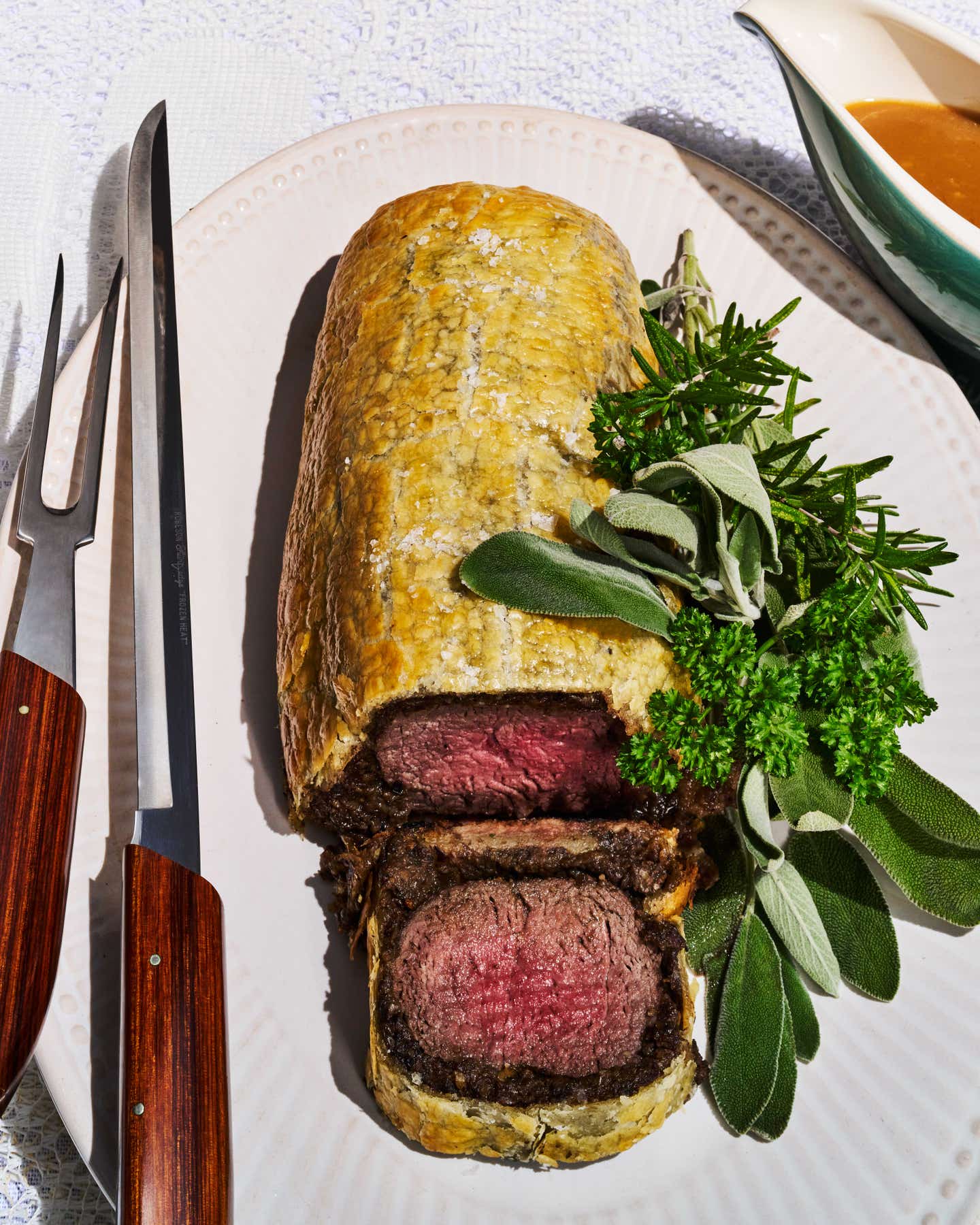Bringing the Flavors of the Shawarma Cart Home
PSA for street food lovers: Here’s how to use the rotisserie-cooked dish’s iconic flavorings in a weeknight-friendly dinner
- Serves
serves 6
- Time
35 minutes
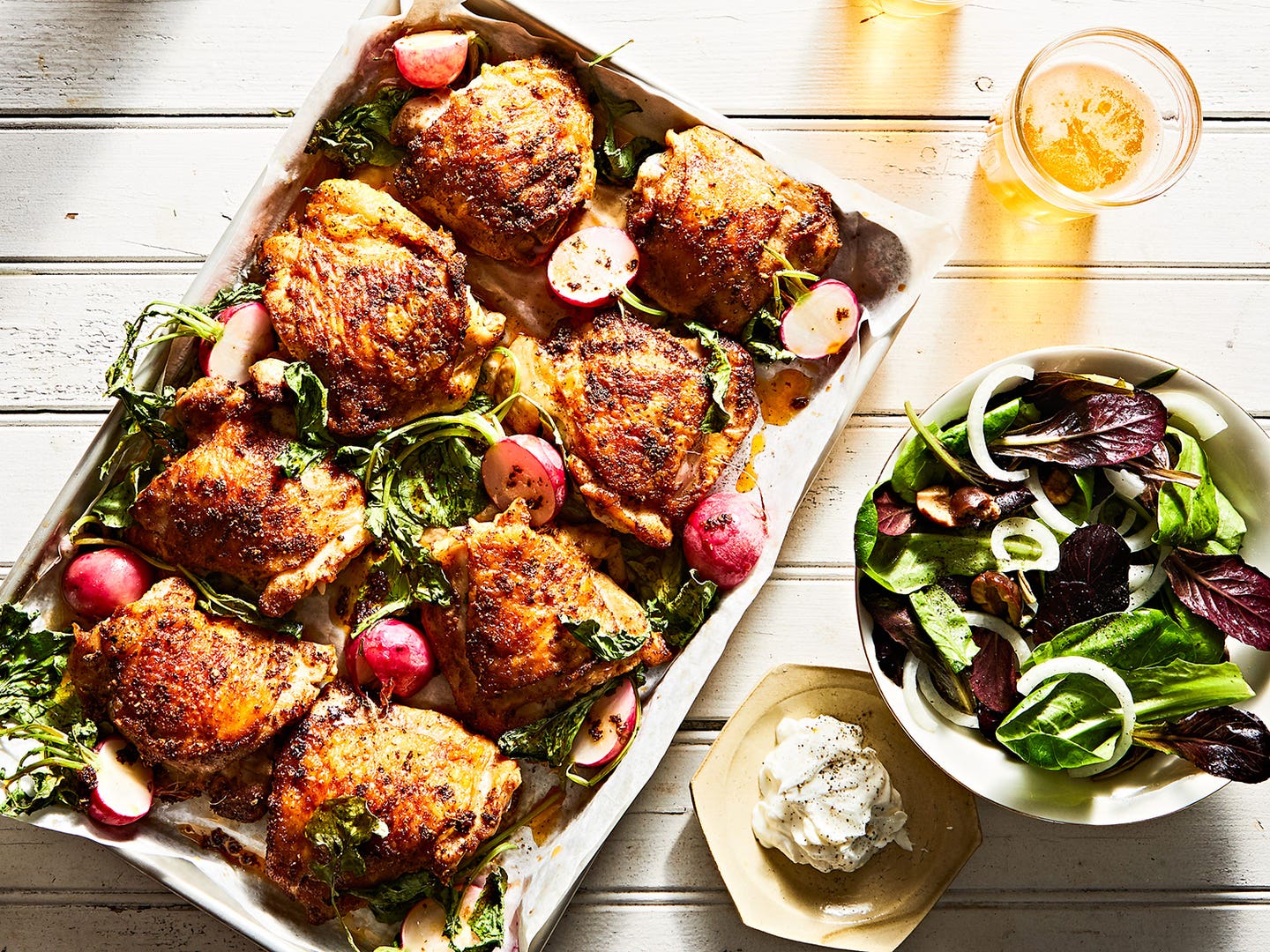
Let's face it: We may never own a giant, swiveling meat rotisserie in our home kitchens. In fact, if you're like us—with kitchen storage cabinets already bursting at the joints—most of the kitchen gear you could feasibly take on would have to be tiny. But does this technical restriction have to mean shawarma flavors at home are forever and fully out of reach?
Not necessarily. You may not be able to shave the meat off a spit of your own, but you can infuse plenty of proteins with shawarma seasonings and cook them in a way that brings out both their tenderness and their crispy edges, inspired by the real thing.
Originating in Turkey ("shawarma" roughly means "turning," which makes good sense), shawarma is primarily a street food, specifically lamb or mutton meat skewered and slow-roasted rotisserie-style with layers of lamb fat and a blend of smoky, fruity, and peppery spices. Traditionally, as the spit turned, the fat would melt down the sides of the shawarma meat, moistening it and helping it caramelize. Shavings of the meat would then be cut off onto a plate or into a pita to order.
Today, shawarma is eaten in many parts of the Middle East, northern Africa, and the Mediterranean. And the word can include any one of a range of meats cooked in a similar method, be it chicken, beef, dark-meat turkey, or veal. Regardless of the meat, the spices that perfume each version tend to stay relatively similar to one another. These often include ground cumin, cardamom, and paprika, and sometimes cinnamon, turmeric, or an accent of nutmeg, allspice, or clove.
Because of the fatty meats and heavy spicing, fresh salads or cooling sauces are often served alongside shawarma, as are pickled vegetables or soft-grilled vegetables. When we’re craving a shawarma-esque meal at home, we seek out an amply fatty and moist meat with potential for crispy edges, and serve it with similarly refreshing sides and accompaniments.
Here’s how else we carved out our favorite properties of shawarma in an easy, family-friendly chicken dinner.
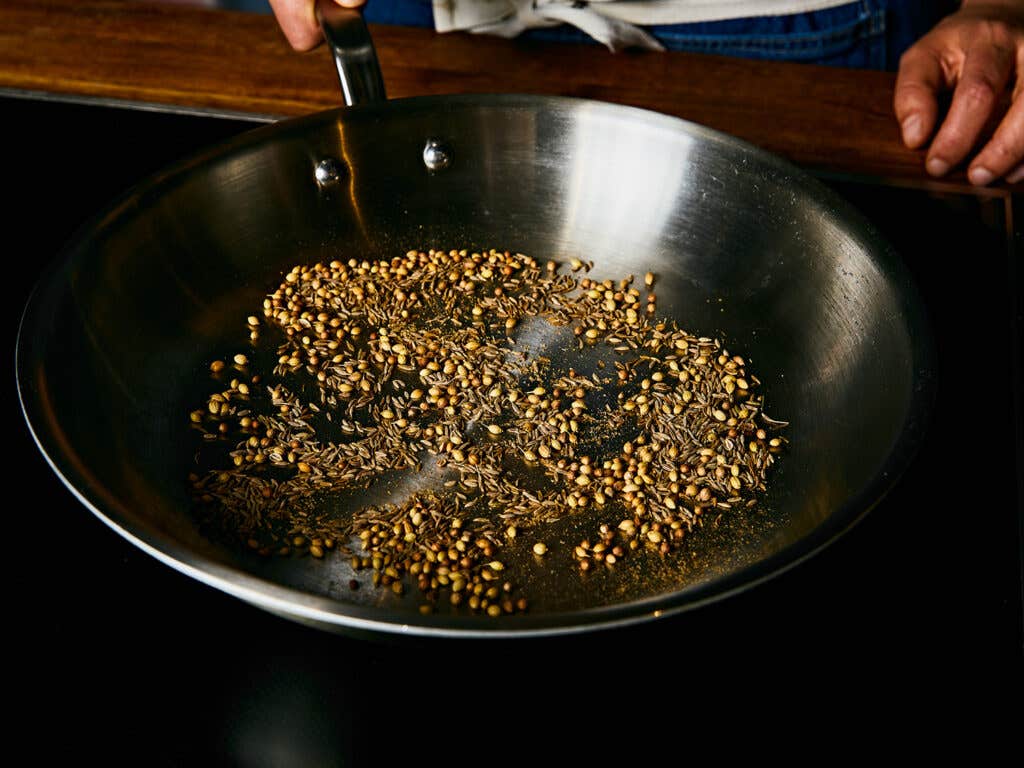
Go Big on Spices
It’s not just one spice—but a balanced combination—that makes up the signature flavors and aromas of street-cooked shawarma. The flavors and proportions vary slightly from cook to cook, but shawarma spice mix often includes cumin, cardamom, and paprika. From there, some vendors will add ground coriander, a dash of cinnamon, clove, allspice, smoked paprika, or a sprinkling of ground turmeric. Others will also layer on a hint of ground chile or pepper to add a subtle kick.
The best way to bring out the intensity of the spice mix is to start with some whole spices and toast them yourself. In a dry skillet, add the spices (in this case cumin and coriander seeds) and cook over medium heat, shaking the pan or stirring the spices, until fragrant and lightly colored in places, 3 to 6 minutes. Remove immediately to a spice grinder or mortar and pestle, then grind (the spices don’t need to be completely fine; a medium coarseness will do). Mix the home-ground spices with pre-ground ones as needed.
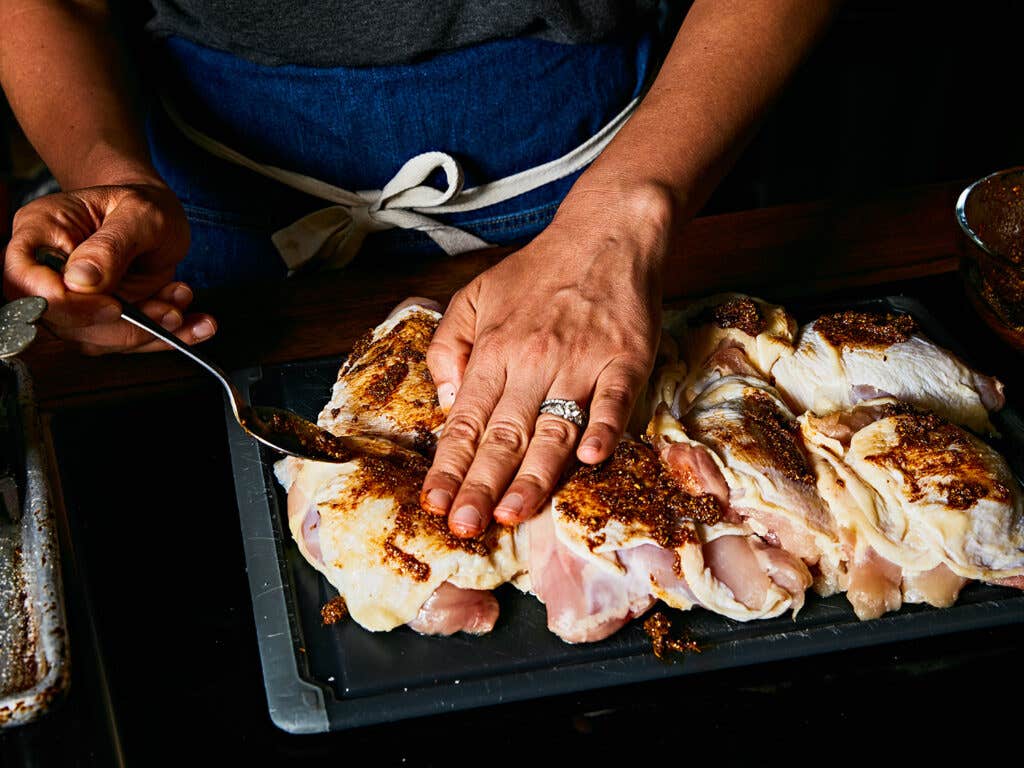
Season with a Rub
Drying off the chicken thighs is key to creating a good, hard sear on the outside that leads to crispy skin. But moistening the spice mix by adding some oil to make a wet rub will help the flavors adhere without adding any wateriness to the pan during the searing process. Be generous with the spice mix, making sure to use it all: Some will inevitably be lost to the cooking process, but you’re going for big flavor.
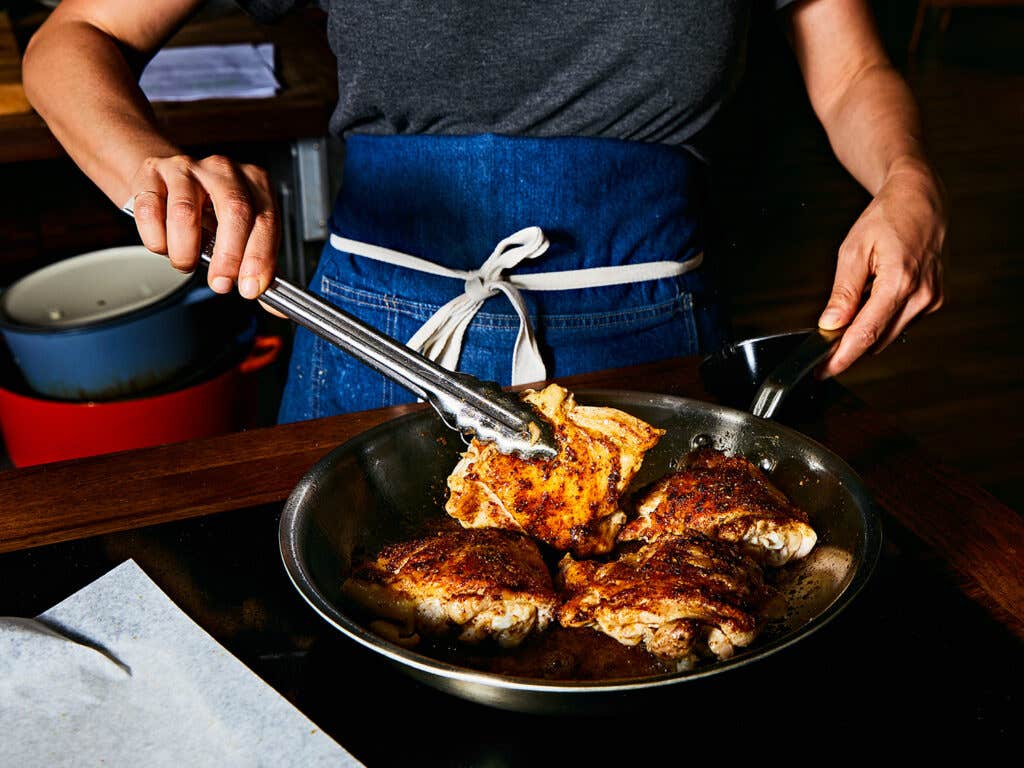
Crisp the Skin
Roasting chicken parts in the oven after searing does two things: It helps the chicken cook all the way through before the outsides burn, and the oven’s heat helps further dry out the skin as it cooks, making for a crispier end result. Be sure to preheat your oven before getting started. And never overcrowd the skillet, one of the keys to golden-brown searing (not steaming). Finally, let the chicken cook until the skin releases easily from the pan, a sign that it’s well browned and no longer as gummy.
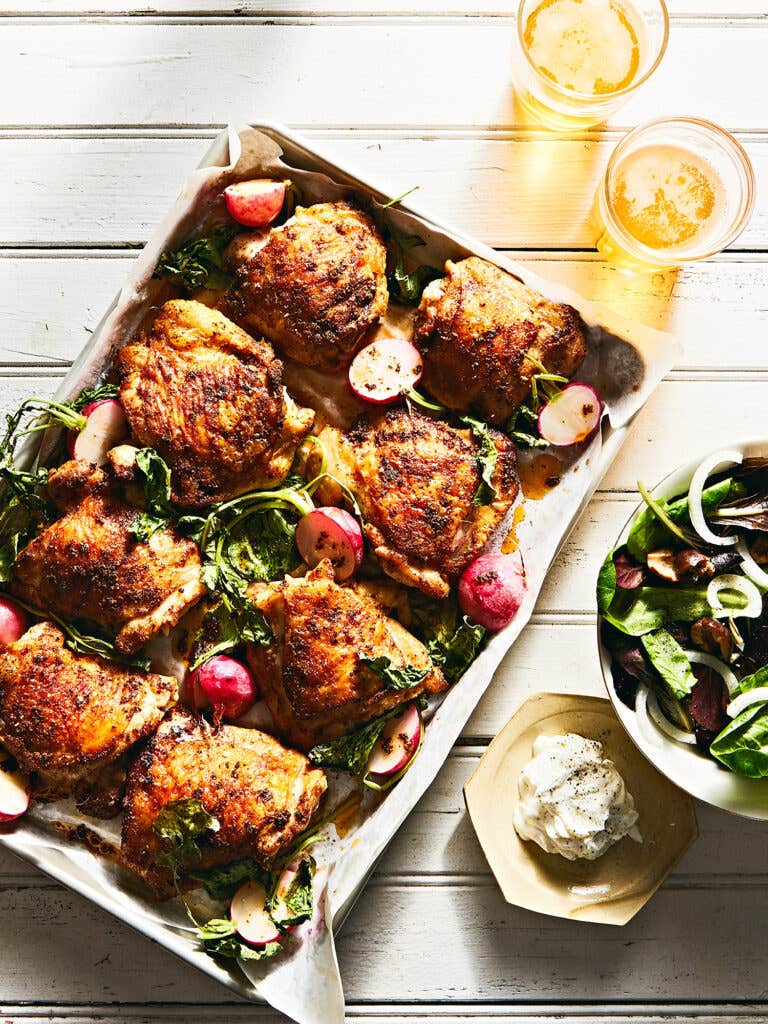
Contrast with Trimmings
Part of the joy of eating a shawarma pita or platter is the sauces and sides that come with the meat. Typically, they’re refreshing, tart, and often physically chilled, making an ideal foil to the highly spiced meat. You can serve these thighs (or any shawarma-spiced meats) with good-quality tahini or a tahini-based sauce, homemade or store-bought pickled vegetables, hummus, thick yogurt, or tangy or hot condiments. A green salad, steamed rice, grain salad, or simple grilled vegetable works well, too. Here, we opted to add crunchy, lightly cooked radishes, which you can roast on the same pan as the chicken to make for a beautiful (and easy) presentation.
Ingredients
- 8 large bone-in, skin-on chicken thighs
- Kosher salt
- 2 Tbsp. cumin seeds
- 2 tsp. coriander seeds
- 2 cloves garlic, grated on a Microplane
- ¾ tsp. paprika
- ¼ tsp. freshly ground black pepper
- ¼ tsp. ground cardamom
- Pinch of ground cinnamon
- Extra-virgin olive oil
- 1 bunch radishes, halved lengthwise and greens reserved
- Plain, full-fat yogurt, Greek yogurt, or labneh, for serving
- Hot sauce, for serving (optional)
- Side salad or cooked rice, for serving (optional)
Instructions
Step 1
Step 2
Step 3
Step 4
Step 5
Step 6
- Preheat the oven to 350°F. Pat the chicken thighs dry using paper towels. Season all over with 1½ teaspoons kosher salt, rubbing to adhere. Let the thighs rest, skin-side up, on a plate until ready to cook.
- Meanwhile, toast the whole spices: In a small, dry skillet, add the cumin and coriander seeds. Heat over medium, shaking the skillet or stirring occasionally, until the spices are aromatic and starting to look very lightly toasted (watch closely for burning), about 3 minutes. Immediately transfer to a spice grinder or mortar and pestle, and grind to a medium-coarse powder.
- Transfer the spices to a medium bowl, then add the garlic, paprika, pepper, cardamom, and cinnamon; stir well. Stir in 1 tablespoon plus 2 teaspoons oil to form a thick paste.
- Cook the chicken: Pat the skin of the thighs dry once more, then season the meat and skin all over with the spice paste, rubbing to adhere. In 2 large stainless-steel, carbon-steel, or cast-iron skillets over medium-high heat, add 1 tablespoon oil to each. When the oil shimmers, carefully slide 4 of the thighs, skin-side down, into each skillet, leaving ample space between the pieces. (Alternatively, you can use 1 skillet and cook the chicken in two batches.) Cook, undisturbed, until the skin is golden brown and pulls away easily from the bottom of the skillet, about 6 minutes. Check the skin of each and rotate the thighs in the skillet as needed (leave them skin-side down) to promote even browning. Continue cooking until the skin is dark brown, about 2 minutes more. Flip the thighs and cook for 1 minute on the remaining side, then turn off the heat.
- Transfer the thighs to a large parchment-lined baking sheet. Arrange the radishes between the thighs in a single layer, and season lightly with salt. Brush the radishes lightly with some of the juices from the skillets. Roast until the chicken is just cooked through but still juicy, and the radishes are firm-tender with lightly crispy greens, 8–10 minutes.
- Serve with yogurt on the side, hot sauce if desired, and a side salad or rice if desired.
Keep Reading
Continue to Next Story

